![]()
| 2001年の瀬戸の正月の風景 Scene of New Year's Day in Seto City [Photos taken on Jan.2, 2001] |
| このページは主に、外国人の閲覧用に作成しました。 This page is mainly for foreigners because the scenes are familiar for the Japanese people. |
| At the mid-night on the last
day of the year(New Year's Eve), we go to worship (the shrine of) the local Shinto deity at the mid-night while listening to the peal of a temple bell hit 108 times to renounce worldly desires. On New Year's Day, each family usually gathers at their parents' house and contacts their hands in front of their family Buddhist altar, burns incense and recites the sutra proper to their own religious sect to pray for the repose of ancestor's soul. After that, they visit the family's grave in the morning and eats lunch out or in their parents' house. People tend to visit shrine(s) for a kind of recreation to pray for their family's health or prosperity. The visiting shrines are mainly two - one is the shrine of the local Shinto deity and the other is the main and popular shrine in the region. So, ordinary people are quite busy for the sake of friendship during the period of Jan 1 to 3. |
| Photos are shown in my walking turn. |
| Please pay attention to the
background color of item nos. 1, 2, 8 and 9. All the photos are taken almost at the same time zone, but the those background color only are light purple. It is very interesting. |
| 1 Washing Place to purify oneself | 2深川神社(注1参照) 深川神社古墳 2Fukagawa Shrine (See Note 1) Ancient mound of Fukagawa Shrine |
3 Hakusan and Ebisu Shrines |
 |
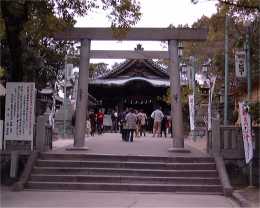 |
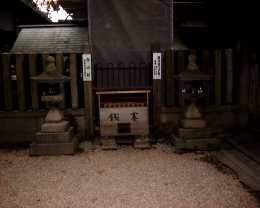 |
| 4 Hachiman and Shinmei Shrines | 5 Inari Shrine | 6 Suehiko Shrine (See Note 2) |
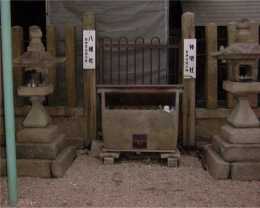 |
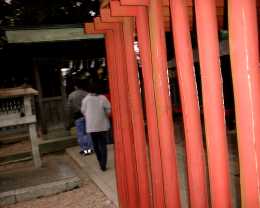 |
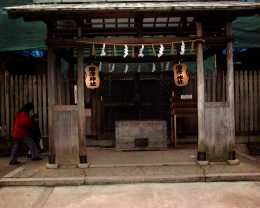 |
| 7 Good luck charms against evil of last year are being burned. |
8 Overall view of the precincts | 9 Stone monument of
KatoTamikichi at Kamagami Shrine (in 15 min. walk from Fukagawa Shrine) (See Note 3) |
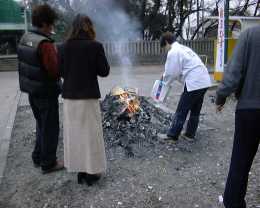 |
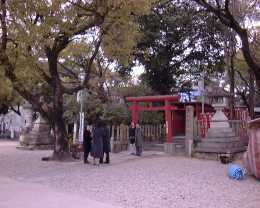 |
 |
| 10 Statue of Kato
Tamikichi (made by copper) |
11 Seto Canyon (See Note 4) | 12 -1 Nagoya Castle |
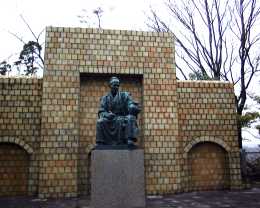 |
 |
Nagoya Castle |
| Note 1: Fukagawa Shrine consists of 6 shrines each named Hakusan, Hachiman, Sinmei, Ebisu, Inari and Suehiko. It is said that Japan is produced by a goddess called 'Amaterasuoomikami' who had 5 sons and 3 daughters. The 8 children are worshipped at Fukagawa Shrine. 深川神社の社殿は拝殿、幣殿、本殿、神楽殿、宝物殿及び社務所から構成される。、母体は 市杵島姫命(いちきしまひめのみこと)を祭神とした深川天神のようです。 "Shaden" (buildings for housing object(s) of worship) of Fukagawa Shrine consists of "Haiden" (building for worshipping deities, in front of which "Saisenbako"[offertory box]is placed), "Heiden" (building for offering "Heihaku"[general designation for objects dedicated to deities]),"Honden"(main building that houses spirit of deities), "Kaguraden"(building for performing sacred Shinto music and dance), "Houmotsuden" (building for storing treasures) and "Shamusho" (building for handling shrine's business affaires). Fukagawa Shrine seemed to originate from Fukagawa Tenjin which worshiped Ichikishimahimeno-mikoto. Note 2: Suehiko Shrine worships Kato Toshiro as the founder of Seto pottery. Note 3: Kamagami Shrine worships Kato Tamikichi as the founder of Seto porcelain. Note 4: Pottery clay and silica sand mining field is called as Seto Canyon because it looks like Grand Canyon in U.S.A. in the appearance. It is located about 500 m north of Kamagami Shrine. |